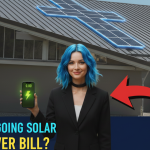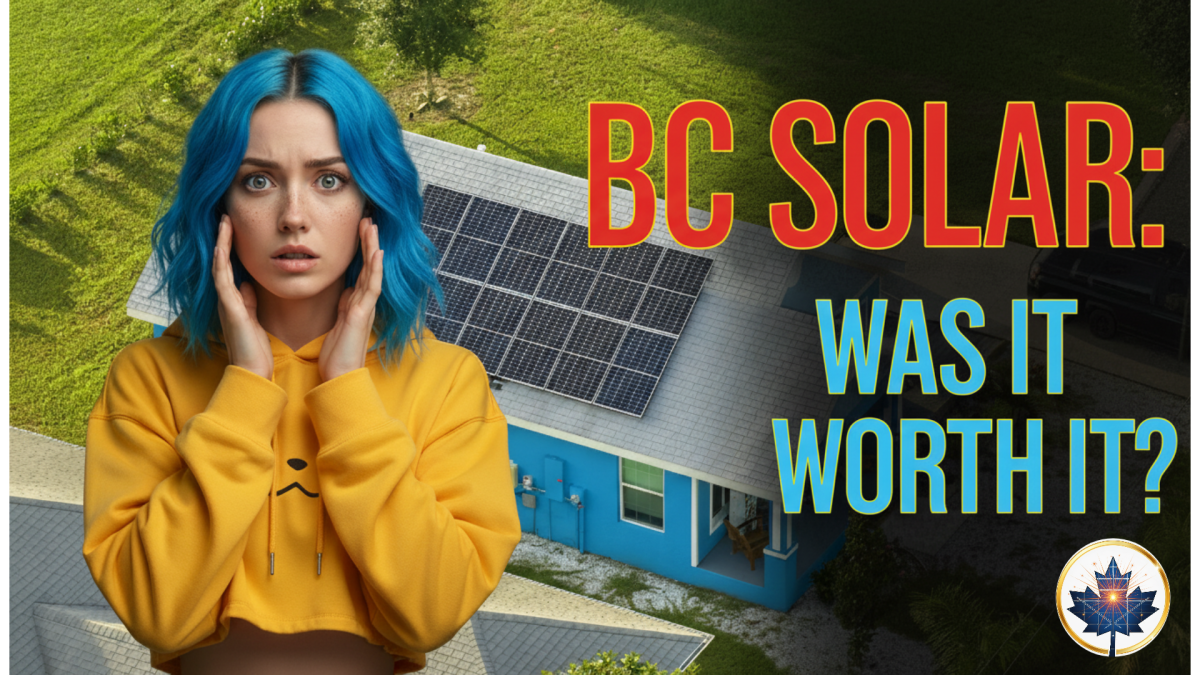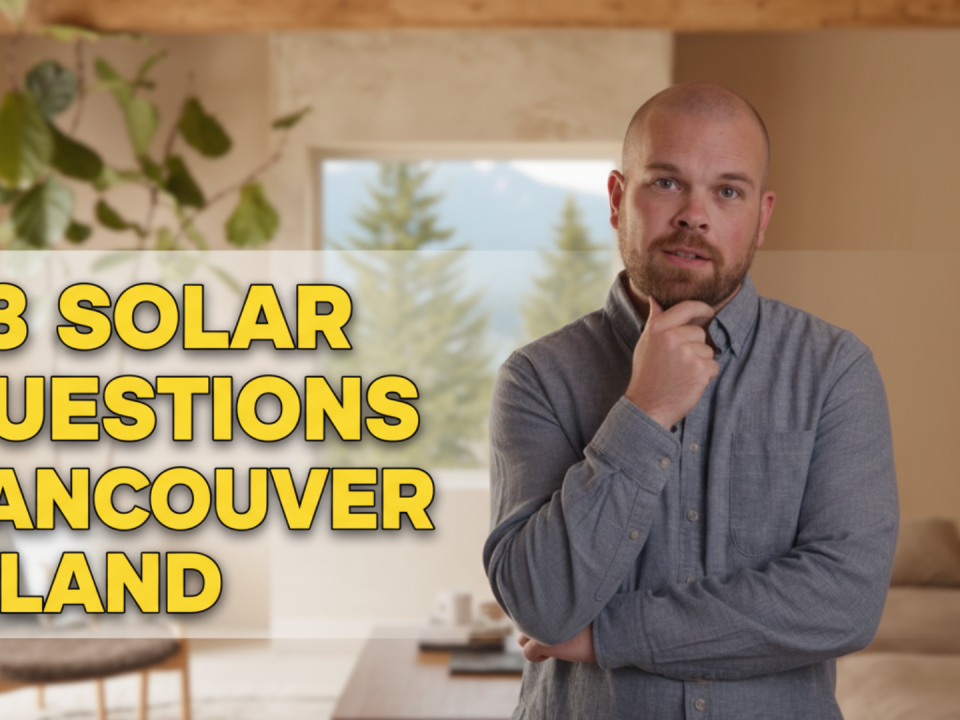
Churches Going Solar in BC, Canada: A Practical How-To Guide
October 10, 2025
Solar Panel Kelowna BC: Installation, Cost and Rebates Explained
October 14, 2025For the last year, the big question I get from homeowners is, “With the federal Greener Homes Grant gone, is solar still a good investment in BC?” It’s a fair question. That grant helped a lot of people make the switch, and its closure left many wondering what’s next.
Well, the entire landscape just shifted after, BC Hydro launched a brand-new, powerful rebate program that makes going solar more affordable than it has been in years. This is a big financial help for a residential solar installation in BC. If you’ve been on the fence, this is the development you’ve been waiting for. We’re going to break down what this actually means for your wallet, how it works, and figure out if this is the right move for you.
Rebates and incentives that help make it worth it!
BC Hydro is offering direct rebates to homeowners who want to generate their own power. This is not a complex loan or a future tax credit; this is money back in your pocket that directly lowers the upfront cost of your solar energy system.
Here’s the simple breakdown from the official BC Hydro Solar Rebate Program:
- A rebate of up to $5,000 for installing eligible grid-connected solar panels.
- An additional rebate of up to $5,000 if you add a battery storage system.
This means you can get up to $10,000 back for a full solar and battery installation. You have the flexibility. You can install just the solar panels and get the $5,000 rebate, or just a battery if you already have panels. But combining them gets you the maximum financial benefit.
How Do You Qualify for the Rebate?
You need to be a BC Hydro residential customer and enroll in their Self-Generation Program. This is the new name for the well-known Net Metering program. It is the framework that allows you to connect your solar system to the grid and earn credits for the extra power you produce. A reputable solar installation company will handle this entire application process for you, as it requires technical details and a study of your proposed system.
How Much Do Solar Panels Cost In BC and What Influences the Price?
This new rebate completely changes the financial picture for a solar investment. Let’s look at the typical costs for a solar power system in British Columbia and see how the numbers change once the incentive is applied.
The final price tag always depends on a few things: the size of your solar array (measured in kilowatts or kW), the quality of the best solar panels in Canada and inverter you choose, and the complexity of your roof. A simple, south-facing roof is easier and therefore less expensive to work on than a roof with many different angles or dormers.
Here is a realistic look at average solar panel costs before and after the new BC Hydro rebate. For a more precise estimate for your home, you can use a solar cost calculator for Victoria, BC, which will give you a good baseline.
| Home / System Size | Average Cost Range (Before Rebate) | Effective Cost After $5,000 Solar Rebate |
|---|---|---|
| Small (4-5 kW) | $10,000 – $16,000 | $5,000 – $11,000 |
| Medium (8-10 kW) | $20,000 – $30,000 | $15,000 – $25,000 |
| Large (12+ kW) | $30,000 – $40,000+ | $25,000 – $35,000+ |
As you can see, the rebate makes a serious dent in the initial investment. This directly shortens the time it takes for the system to pay for itself.
And don’t forget the other financial perks still in play for homeowners in BC:
- BC PST Exemption: You save the 7% Provincial Sales Tax on your entire solar panel system. On a $25,000 system, that’s an immediate $1,750 you don’t have to pay.
- 0% Financing: The market has adapted since the federal loan program ended. There are now excellent ways to finance your solar panels with 0% interest (it is not available to most companies, just a lucky few—us) and no down payment. This means you can start without a large upfront cash payment, and the monthly payments are often designed to be close to what you were already paying BC Hydro.
Understanding BC Hydro’s Self-Generation Program
Joining this program is a must to get the rebate, and it’s the financial engine that makes your solar investment profitable year after year. It’s a simple concept but powerful in practice. The ability to sell solar energy back to the power company in Canada is what makes grid-tied solar so effective.
- Use Your Own Power First: When the sun is shining, your home runs on the free, clean electricity your solar panels generate. You aren’t pulling power from the grid, so you aren’t paying for it.
- Export Excess Power for Credits: On long, sunny BC days, your system will likely produce more electricity than your home needs. This excess solar energy is automatically sent to the grid, and BC Hydro credits your account at the full retail price for every kilowatt-hour (kWh) you send them.
- Use Credits When You Need Them: At night, or on a cloudy winter day, you draw power from the grid just like you do now. The difference is, you use your banked credits to pay for that electricity instead of your wallet.
This system is so effective because of BC Hydro’s two-tiered electricity rate. You pay a lower rate (Step 1) for a base amount of energy each month, and a higher rate (Step 2) for all electricity used beyond that. Your solar credits are automatically applied against the more expensive Step 2 rate first, maximizing your savings.
If you still have credits left over on your annual anniversary date (March 1st), BC Hydro will pay you out for that excess energy at the market price.
Battery Rebate makes it worthwhile.
In the past, adding a battery to a residential solar setup was a major extra expense, often making it a luxury. Now, with a $5,000 direct rebate, it’s a much more practical and strategic choice. A battery fundamentally changes your relationship with energy. It’s the key to unlocking the full potential of your solar panels.
From my experience working with homeowners, a solar panel system paired with a battery can cover up to 95% of a home’s total electricity needs.
Here’s why it’s so effective:
- Energy Shaving: This is the biggest benefit. You store the free solar power you generate during the day in your battery. In the evening, when your panels aren’t producing and electricity rates are high, your home runs on the stored battery power instead of buying expensive electricity from the grid.
- Energy Independence: You become far less reliant on the grid. You are in control of your own power source.
- Backup Power: When a storm causes a power outage, a home with a solar battery like a Tesla Powerwall can keep the lights on, the fridge running, and the internet connected. For many in BC, this peace of mind alone is a huge benefit.
I recently worked with a family in the Fraser Valley who installed a 10 kW solar system with a battery. Their main driver was their two electric vehicles. Their BC Hydro bill was getting unpredictable. Now, they charge their cars overnight from the battery, which was filled with free sun-power during the day. The $5,000 rebate made the decision to add the battery a no-brainer for them.
It Is Worth It If Your House is a Good Fit for Solar
Before you can apply for the rebate program and install solar panels, a professional installer will need to confirm a few key things about your property. Not every home is a perfect candidate, so an honest assessment is the first step.
- Roof Direction and Angle: A south-facing roof is the ideal scenario in the northern hemisphere for maximum solar energy production. However, east and west-facing roofs are also highly effective, especially for capturing morning and afternoon sun. They typically produce about 15-20% less energy annually than a perfect south-facing roof, a factor a good designer will account for.
- Roof Condition: Your solar panels will be up there for 25 to 30 years, so your roof needs to be in good shape. It should have at least 15 more years of life in it. If you’re due for a new roof in the next 5-10 years, it’s far more cost-effective to do the roofing project before the solar installation.
- Available Space: Your roof needs enough clear, unobstructed space to fit the number of solar panels required to meet your energy goals. A standard panel is roughly 1.1 by 1.8 meters.
- Shading: This is a critical factor. Your roof must be free from significant shade cast by trees, chimneys, or nearby buildings, especially during the peak sun hours of 9 a.m. to 3 p.m. It’s one of the biggest solar panel myths that Canadians still believe that panels work well in the shade; they don’t. A little bit of morning or evening shade is often manageable, but shade during the middle of the day will seriously impact your energy production.
Tip for Homeowners: A professional solar company will use satellite imaging and software to do a detailed shade analysis of your roof before you ever sign a contract. This report will show you exactly how much sun your roof gets annually and what your expected energy production will be. Don’t be afraid to ask for this, and be sure to have a list of questions to ask any solar company before you commit.
The Bottom Line: A Faster Payback and Real Savings
So, what does this all mean for the average homeowner in BC?
The old math for solar, before this rebate, pointed to a payback period of 10-15 years. With up to $10,000 in direct rebates from BC Hydro, that timeline shrinks considerably. For many, the payback period will now fall into the 7-10 year range. After that, the electricity your system produces is essentially free. This is the core of how solar panels pay for themselves in Canada.
Of course, the only way to know the exact numbers for your home is to have a professional analyze your past BC Hydro bills. Your unique electricity consumption pattern determines the ideal size for your solar system. But the starting point for that calculation has never been this good.
For many homeowners, the monthly payment on a 0% financing plan will be very close to their old average hydro bill. You’re effectively swapping your volatile utility bill for a fixed payment on an asset that adds value to your home and protects you from future electricity rate increases. And you can feel confident in the long-term performance, as we have a good understanding of what happens to solar panels after 25 years. Additionally, homeowners can explore various alternative solar financing methods that cater to their unique financial circumstances, further expanding their options. These methods can include leasing agreements or power purchase agreements (PPAs), which may require little to no upfront costs. By considering these alternatives, homeowners can still enjoy the benefits of solar energy while maintaining financial flexibility.
Is Now a Good Time to Go Solar in BC?
This isn’t just a good time; it’s the best time we’ve seen in years. The powerful combination of a direct $10,000 rebate from BC Hydro, the ongoing PST exemption, and available 0% financing
If you’re ready for a custom study or want more details on the 0% financing options available in BC, chat with my assistant now in the left corner at the bottom. Just leave your email and phone number, and we will follow up with you to provide a free, no-obligation analysis.





6 Comments
Ciao, volevo sapere il tuo prezzo.
Hi, kam dashur të di çmimin tuaj
Salut, ech wollt Äre Präis wëssen.
Kaixo, zure prezioa jakin nahi nuen.
হাই, আমি আপনার মূল্য জানতে চেয়েছিলাম.
Ողջույն, ես ուզում էի իմանալ ձեր գինը.